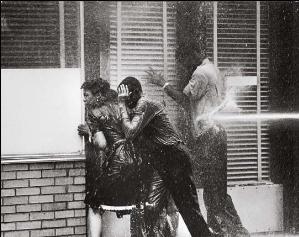Related Research Articles

The 1954-1968 civil rights movement in the United States was preceded by a decades-long campaign by African Americans and their like-minded allies to end legalized racial discrimination, disenfranchisement and racial segregation in the United States. The movement has its origins in the Reconstruction era during the late 19th century, although it made its largest legislative gains in the mid-1960s after years of direct actions and grassroots protests. The social movement's major nonviolent resistance and civil disobedience campaigns eventually secured new protections in federal law for the human rights of all Americans.

Jamil Abdullah Al-Amin, formerly known as H. Rap Brown, is a civil rights activist and convicted criminal who was the fifth chairman of the Student Nonviolent Coordinating Committee in the 1960s. During a short-lived alliance between SNCC and the Black Panther Party, he served as their minister of justice.

The Southern Christian Leadership Conference (SCLC) is an African-American civil rights organization. SCLC is closely associated with its first president, Martin Luther King Jr., who had a large role in the American civil rights movement.

The Greensboro sit-ins were a series of nonviolent protests in February to July 1960, primarily in the Woolworth store—now the International Civil Rights Center and Museum—in Greensboro, North Carolina, which led to the F. W. Woolworth Company department store chain removing its policy of racial segregation in the Southern United States. While not the first sit-in of the civil rights movement, the Greensboro sit-ins were an instrumental action, and also the best-known sit-ins of the civil rights movement. They are considered a catalyst to the subsequent sit-in movement, in which 70,000 people participated. This sit-in was a contributing factor in the formation of the Student Nonviolent Coordinating Committee (SNCC).

The Nashville sit-ins, which lasted from February 13 to May 10, 1960, were part of a nonviolent direct action campaign to end racial segregation at lunch counters in downtown Nashville, Tennessee. The sit-in campaign, coordinated by the Nashville Student Movement and the Nashville Christian Leadership Council, was notable for its early success and its emphasis on disciplined nonviolence. It was part of a broader sit-in movement that spread across the southern United States in the wake of the Greensboro sit-ins in North Carolina.

The Birmingham campaign, also known as the Birmingham movement or Birmingham confrontation, was an American movement organized in early 1963 by the Southern Christian Leadership Conference (SCLC) to bring attention to the integration efforts of African Americans in Birmingham, Alabama.
Gloria Richardson Dandridge is best known as the leader of the Cambridge movement, a civil rights struggle in the early 1960s in Cambridge, Maryland, on the Eastern Shore. Recognized as a major figure in the Civil Rights Movement at the time, she was one of the signatories to "The Treaty of Cambridge", signed in July 1963 with Attorney General Robert F. Kennedy, and state and local officials after the riot the month before.
The Atlanta Student Movement was formed in February 1960 in Atlanta by students of the campuses Atlanta University Center (AUC). It was led by the Committee on the Appeal for Human Rights (COAHR) and was part of the Civil Rights Movement.
The Cambridge riot of 1967 was one of 159 race riots that swept cities in the United States during the "Long Hot Summer of 1967". This riot occurred on July 24, 1967 in Cambridge, Maryland, a county seat on the Eastern Shore. For years racial tension had been high in Cambridge, where black people had been limited to second-class status. Activists had conducted protests since 1961, and there was a riot in June 1963 after the governor imposed martial law. "The Treaty of Cambridge" was negotiated among federal, state, and local leaders in July 1963, initiating integration in the city prior to passage of federal civil rights laws. The events of 1967 were much more destructive to the city.

The Biloxi wade-ins refers to three protests that were conducted by local African Americans on the beaches of Biloxi, Mississippi between 1959 and 1963, during the civil rights movement. The demonstrations were led by Dr. Gilbert R. Mason, Sr. in an effort to desegregate the city's 26 mi (42 km) of beaches on the Mississippi Gulf Coast. This was a local effort, without involvement from the state or national NAACP.
This is a timeline of the 1947 to 1968 civil rights movement in the United States, a nonviolent mid-20th century freedom movement to gain legal equality and the enforcement of constitutional rights for People of Color. The goals of the movement included securing equal protection under the law, ending legally established racial discrimination, and gaining equal access to public facilities, education reform, fair housing, and the ability to vote.
Eroseanna “Sis” Robinson (1924–1976) was an African-American social worker, track star, activist and member of the Peacemakers who organized for desegregation and against the U.S. military in the 1950s and 1960s. In particular, she was an advocate of nonviolent resistance strategies. Robinson went on hunger strike or risked violence and arrest multiple times, but nonetheless won various victories for equality.

The sit-in movement, sit-in campaign or student sit-in movement, were a wave of sit-ins that followed the Greensboro sit-ins on February 1, 1960 in North Carolina. The sit-in movement employed the tactic of nonviolent direct action and was a pivotal event during the Civil Rights Movement.
Stanley E. Branche was a civil rights leader from Pennsylvania who worked as executive secretary in the Chester, Pennsylvania branch of the National Association for the Advancement of Colored People (NAACP) and founded the Committee for Freedom Now (CFFN).
The Americus movement was a civil rights protest that began in Americus, Georgia, United States, in 1963 and lasted until 1965. It was organized by the Student Nonviolent Coordinating Committee along with the NAACP. Its main goals were voter registration and a citizenship education plan.
The Cambridge movement was an American social movement in Dorchester County, Maryland, led by Gloria Richardson and the Cambridge Nonviolent Action Committee. Protests continued from late 1961 to the summer of 1964. The movement led to the desegregation of all schools, recreational areas, and hospitals in Maryland and the longest period of martial law within the United States since 1877. Many cite it as the birth of the Black Power movement.
The Chester school protests were a series of demonstrations that occurred from November 1963 through April 1964 in Chester, Pennsylvania. The demonstrations focused on ending the de facto segregation that resulted in the racial categorization of Chester public schools, even after the landmark Supreme Court case Brown v. The Board of Education of Topeka (1954). The racial unrest and civil rights protests were led by Stanley Branche of the Committee for Freedom Now (CFFN) and George Raymond of the National Association for the Advancement of Colored Persons (NAACP).
The Committee for Freedom Now (CFFN) was an American civil rights organization in Chester, Pennsylvania, that worked to end de facto segregation and improve the conditions at predominantly black schools in Chester. CFFN was founded in 1963 by Stanley Branche along with the Swarthmore College chapter of Students for a Democratic Society and Chester parents. From November 1963 to April 1964, CFFN and the Chester chapter of the NAACP, led by George Raymond, initiated the Chester school protests which made Chester a key battleground in the civil rights movement.
Prior to the civil rights movement in South Carolina, African Americans in the state had very few political rights. South Carolina briefly had a majority-black government during the Reconstruction era after the Civil War, but with the 1876 inauguration of Governor Wade Hampton III, a Democrat who supported the disenfranchisement of blacks, African Americans in South Carolina struggled to exercise their rights. Poll taxes, literacy tests, and intimidation kept African Americans from voting, and it was virtually impossible for someone to challenge the Democratic Party, which ran unopposed in most state elections for decades. By 1940, the voter registration provisions written into the 1895 constitution effectively limited African-American voters to 3,000—only 0.8 percent of those of voting age in the state. Jim Crow laws, legalized by the Supreme Court case Plessy v. Ferguson (1896), created a district color line across the South. African Americans were prohibited from using the same facilities as white Americans, and African-American children were prohibited from attending white schools; schools meant for colored children were typical of lower quality than white schools. Public segregation and voting restrictions were eventually reversed after the events of the civil rights movement in South Carolina and the United States during the 1950s and the 1960s.
References
- ↑ Osorio, Yari (2013-02-09). "Cambridge, Md. 50 years ago: when the civil rights movement hit back". Liberation News. Retrieved 2017-03-14.
- ↑ "Veterans of the Civil Rights Movement -- History & Timeline, 1962". www.crmvet.org. Retrieved 2017-03-14.
- 1 2 3 "Veterans of the Civil Rights Movement -- History & Timeline, 1963 (Jan-June)". www.crmvet.org. Retrieved 2017-03-14.
- ↑ "Cambridge, Maryland, Demonstrations (1963–1967) | Freedom Facts and Firsts: 400 Years of the African American Civil Rights Experience - Credo Reference". search.credoreference.com. Retrieved 2018-01-15.
- 1 2 3 Smith, Hedrick (July 13, 1963). "Martial Law is Imposed in Cambridge, Md., Riots". The New York Times. ISSN 0362-4331 . Retrieved March 10, 2017.
- 1 2 "6 Shot in Maryland Riot". The Chicago Tribune. July 12, 1963. Retrieved March 10, 2017.
- ↑ "Cambridge, Maryland, Demonstrations (1963–1967) | Freedom Facts and Firsts: 400 Years of the African American Civil Rights Experience - Credo Reference". search.credoreference.com. Retrieved 2018-01-15.
- ↑ dholt@chespub.com, DUSTIN HOLT (Jul 23, 2017). "Author debunks riot myth". Dorchester Star.
- ↑ Levy, Peter B. (2018-01-25). The Great Uprising. Cambridge University Press. pp. 70–89. ISBN 9781108422406.